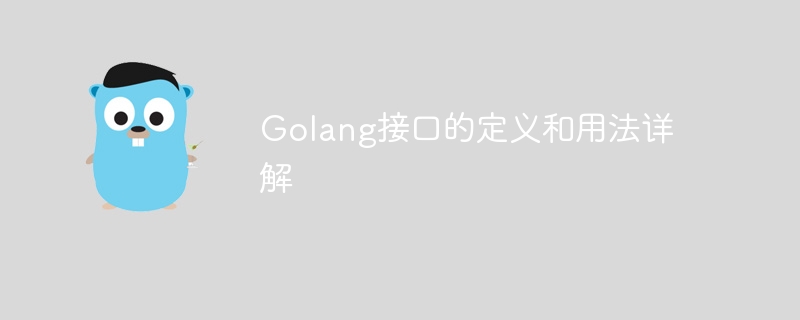

Detailed explanation of the definition and usage of Golang interface
In the Go language, an interface (interface) is a type that defines the behavior of an object and a collection of methods of an abstract object. An interface defines the methods that an object should have without specifying how these methods are implemented. This flexibility makes interfaces one of the most powerful and commonly used features of the Go language.
In the Go language, the interface is defined by the keyword interface, usually as follows:
type 接口名 interface {
方法名1(参数列表) 返回值列表
方法名2(参数列表) 返回值列表
// 更多方法...
}For example, define A simple animal interface:
type Animal interface {
Speak() string
}The above code defines a Animal interface that contains the Speak() method. Any type that implements the Speak() method is considered to implement the Animal interface.
To implement an interface, you only need to define the corresponding method in the type. For example, define a dog type to implement the Animal interface:
type Dog struct {
Name string
}
func (d Dog) Speak() string {
return "汪汪汪"
}In the above code, the Dog type implements the Speak() method, Therefore, it can be considered that the Dog type implements the Animal interface.
In Go language, object polymorphism is achieved through interfaces. Specifically, if an object implements all methods in the interface, then the object can be assigned to the interface type and the corresponding method can be called through the interface type. For example:
func LetAnimalSpeak(animal Animal) {
fmt.Println(animal.Speak())
}
func main() {
var a Animal
a = Dog{Name: "旺财"}
LetAnimalSpeak(a) // 输出:汪汪汪
}In the main function, we assign an object of type Dog to the Animal interface type and call LetAnimalSpeak function. Since the Dog type implements the Animal interface, the program will output woof woof woof.
In Go language, interfaces can be nested in other interfaces, or new interfaces can be formed through interface combination. This can better organize the code and make the interface more expressive and reusable. For example, define an interface that contains movement methods:
type Move interface {
Run()
Jump()
}
type Animal interface {
Speak() string
Move
} In the above code, the Animal interface forms a new interface by nesting the Move interface, including Speak() method and Move method in the interface.
In the Go language, the empty interface interface{} does not contain any methods, so it can represent any type. The empty interface is very useful when multiple types of data need to be represented. For example, the fmt.Print function accepts parameters of the empty interface type.
func PrintData(data interface{}) {
fmt.Println(data)
}
func main() {
PrintData(42) // 输出:42
PrintData("hello") // 输出:hello
}Through the above examples, we have explained in detail the definition and usage of the Golang interface, as well as how to implement and use the interface. Interfaces are a very important feature in the Go language, which can help us better organize and abstract code and achieve flexible and scalable programming. I hope that through the explanation of this article, readers can better understand and apply the usage of interfaces in the Go language.
The above is the detailed content of Detailed explanation of the definition and usage of Golang interface. For more information, please follow other related articles on the PHP Chinese website!
 Usage of Type keyword in Go
Usage of Type keyword in Go
 How to implement linked list in go
How to implement linked list in go
 What are the Go language programming software?
What are the Go language programming software?
 How to learn go language from 0 basics
How to learn go language from 0 basics
 How to repair lsp
How to repair lsp
 What are the methods to implement operator overloading in Go language?
What are the methods to implement operator overloading in Go language?
 What are the operators in Go language?
What are the operators in Go language?
 How to export word from powerdesigner
How to export word from powerdesigner
 oracle clear table data
oracle clear table data




